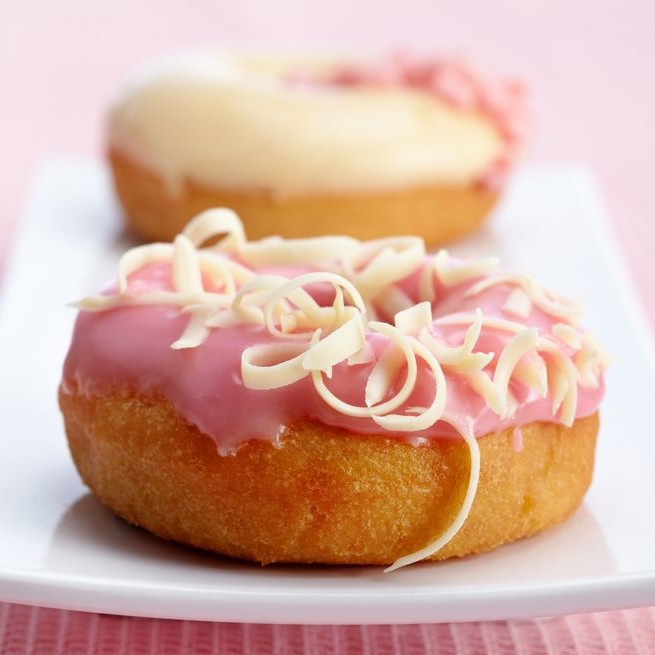
Cake Donuts
Also known as chemically-leavened doughnuts
What are Cake Donuts?
Cake donuts are amongst the most iconic and most popular U.S. bakery products. They are made from a cake batter that is chemically-leavened and fried to develop its traditional taste and aroma.
Given their formulation and processing, cake donuts are one of the most challenging bakery products to manufacture.
Origin
The origin of donuts is not very clear. However, there is some evidence that these sweet cakes were originally made in Holland in the 19th century in the form of round cakes. Upon frying the outer part of the donuts developed a brown color while the inside remains uncooked. Attempts to rectify this drawback, Dutch bakers stuffed the cakes with fruits and nuts which did not require cooking.
Later in 1847 an American ship captain, Hansen Gregory, found a better solution by punching a hole in the doughnut dough to eliminate the uncooked center. Donuts did not become a significant bakery product until the 1920s, when the first automatic doughnut machines became available.
Currently, hundreds of millions of donuts are enjoyed. It is estimated that 3 pounds (around 1.5 Kg) of donuts are consumed per person each year in the United States.
How are they made?
Cake donuts can be produced from scratch or by using commercial mixes containing all dry ingredients. Mixes are preferred by high-speed operations and some retail bakeshops. The following formula uses doughnut mix (ready-to-use dry blend):
| Ingredient | True % (based on total dry mix weight) |
| Soft wheat flour (70%) / Hard wheat flour (30%) | 55.0–65.0 |
| Soy flour (defatted) | 1.0–3.0 |
| Sucrose | 20.0–35.0 |
| Dextrose | 0.0–5.0 |
| Nonfat dry milk | 3.0–5.0 |
| Dried egg yolk | 0.5–3.0 |
| Fat / soybean oil* | 3.0–10.0 |
| Salt | 1.0–1.5 |
| Water | 45.0–55.0 |
| Pregel potato starch | 0.0–2.0 |
| Lecithin | 0.0–0.5 |
| Emulsifier* | 0.1–0.5 |
| Chemical leavener (baking powder) | 1.5–3.5 |
| Flavor (nutmeg, cinnamon and sour cream) | Varies |
| Gums (CMC, xanthan gum) | 0.1–0.5 |
| Mold inhibitors | 0.1 |
| Water | 35.0–45.0** |
* Pre-blend and dispersion of oil / melted shortening with emulsifier. Mixture is then sprayed and incorporated into the other dry ingredients.
** Based on total mix weight.
Processing
- Formulation of the doughnut mix and blending of dry ingredients.
- Scaling / metering of water and other ingredients.
- Batter mixing. Mix for 1–2 minutes at low speed and 2 minutes at second speed to evenly incorporate and hydrate ingredients, and aerate the batter.
- Final batter temperature should be between 70–75°F (21–24°C) to maintain stability and viscosity and avoid excessive gas production and loss. Water temperature should be adjusted based on final batter temperature.
- Floor time and transfer of batter to the depositor. 10–30 minutes of floor time to ensure further hydration of dry ingredients.
- Cutting/depositing.
- Frying by partial immersion in oil at a temperature of 375–385°F (190–195°C) for 45–60 seconds per side (donuts must be turned over when half done). Avoid frying at lower temperatures to reduce oil absorption and development of under-processing defects.
- Glazing (optionally applied to product when still hot).
- Cooling to internal temperature of 90–95°F (32–35°C) before packaging.
- Icing, coating or enrobing (optional, applied to cooled product).
Application
Cake doughnut production proceeds at very fast rates leaving a very small window between mixing and frying stages, so proper scheduling of the operations is a must. The batter dropped into the frying fat must rise to the surface (become less dense) very quickly so that it can be conveyed at the surface by the flights of the continuous fryer, or the next batter piece will be dropped on top of the previous deposited donut.1
Cake doughnut formulations and/or dry mixes contain baking powders with fast-acting leavening acids (e.g. SAPP 40, SAPP 43) to quickly produce and CO2 gas and maintain rise time between 3–7 seconds.
Ways to reduce or limit fat absorption during frying:1,2
- Increase water absorption of batter. More gums can be added to maintain batter viscosity and retain product shape if more water is needed.
- Use greater proportions of hard wheat flour (higher protein content).
- Decrease levels of enriching and tenderizing ingredients such as sugars and fat. Batters that are too rich will browning and absorbing too much frying fat.
- Increase levels of structure-building ingredients such as proteins (soy flour, eggs, nonfat dry milk).
References
- Finnie, S., and Atwell, W.A. “Products from Soft Wheat Flour.” Wheat Flour Handbook, 2nd edition, Cereals & Grains Associations, AACC International, Inc., 2016, pp. 111–124.
- Gisslen, W. “Doughnuts, Fritters, Pancakes, and Waffles.” Professional Baking, 7th edition, John Wiley & Sons, Inc., 2017, pp. 229–232.

